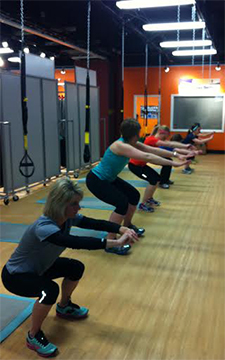5 Common Errors in Half and Full Marathon Training
Half and full marathon training is in full swing. Our mileage is building, the trails are filling up… and many of us are well on our way to making a few regrettable errors during training.
We all go into training with good intentions, but all too frequently we fall into the same traps and blunders year after year. The key is to navigate the treacherous training waters and safely reach the finish line. Don’t waste valuable training time making avoidable mistakes. Take a lesson from these common errors.
1. Too Hard on Easy Days We are goal-oriented people; therefore, we have a hard time accepting that our easy days should be EASY. I love GPS units, but they've only added to this phenomenon. We become fixated on a certain pace. How on earth can I possibly race fast if I run this slow? Simple. There are specific physiological adaptations we want to occur on our easy days. The problem is that too often, people push right past that stimuli's efficient zone and end up completely missing out on the benefits of that training day. Take note: If you are in solid half or full marathon training, it's almost impossible to run too slow on your easy day.
We are goal-oriented people; therefore, we have a hard time accepting that our easy days should be EASY. I love GPS units, but they've only added to this phenomenon. We become fixated on a certain pace. How on earth can I possibly race fast if I run this slow? Simple. There are specific physiological adaptations we want to occur on our easy days. The problem is that too often, people push right past that stimuli's efficient zone and end up completely missing out on the benefits of that training day. Take note: If you are in solid half or full marathon training, it's almost impossible to run too slow on your easy day.
2. Not Listening to Your Body
This is a close cousin of our first error. Our bodies are incredible. We can do and adapt to more than seems possible. Because of this, we also have the capability to run ourselves right into the ground. As I said before, our GPS units are a great tool to help with training, but they are not the Holy Grail to unlocking that next great race performance. We must learn to listen to our bodies and allow them to run how they feel. Don't worry about what the watch says. Listening to your body also means not becoming a slave to your training schedule either. Schedules are a scaffolding to help us see the forest through the trees. However, they are not written in stone. We must be able to adapt to what our bodies are telling us. If our bodies are giving us the finger, then we just might need to take the day off or cut that long run short. When we are beaten up, we need to heed our bodies’ warnings and work on avoiding Common Error 3…
3. No Supplemental Training
We are asking a lot of our bodies during training. Considering we take around 1800 steps per mile, with several times our body weight loaded into each step, you can see how our bodies might develop some soreness and tightness. We tend to do a great job of getting our runs in, but neglect the supplemental training that makes the running possible. Foam rollers should be a half and full marathoner’s best friend, not something that sits in the corner collecting dust. Throughout training, our bodies are developing myofascia. As that builds, we get tighter and tighter until we start to develop overuse injuries due to limited range of motion. By utilizing myofascial release, we can help maintain our  muscles’ range of motion and stay ahead of many nagging injuries that can derail a great training season.
muscles’ range of motion and stay ahead of many nagging injuries that can derail a great training season.
Strengthening our muscles helps prevent injuries as well. We have well over 600 muscles in our body. No one has all of them balanced, strong, and supple. Training does a tremendous job of finding the weak muscles and causing that link to break. By incorporating some supplemental muscle activation strength training into our training program, we can prevent many of the common mechanisms that nuke our race before the start line.
4. Knee-Jerk Overreaction
Training is not linear. We will have good days and bad days (hence the reason Common Error 2 is on the list). As I said in that section, our schedule is a scaffolding to follow, not an ironclad contract to be followed at all costs. That being said, it is also not something to eschew. Our training program allows us to stay on target without wandering too far away from out primary goal. The problem is that all too often, when we have one of those rough days (or weeks), we scrap everything and change directions mid-course. Half and full marathon training is written with the intent of having good days and bad days. We can’t get too high on the good days and we can’t get too low on the bad days. The reason we need to stick with the program is that the rough patch is taken into account in the program itself. By overreacting, we miss out on the benefits that may just be around the corner. In the end, if we keep switching things up as a knee-jerk reaction, we end up missing the training effects of any and all programs. Training for a half or full is like the race itself: it's not a sprint. We have to train intelligently and patiently if we are survive safely and happily.
5. Not Preparing for Race Day It’s easy to get so caught up in training and logging our miles that we lose sight of the fact that this is all set up for a half or full marathon. We learn to train just to train and miss out on training to race. One of the primary things people neglect in training is race day fueling, both pre- and mid-race. Many a race has been sabotaged because we aren’t deliberate in finding out what our bodies—and stomachs—like. We are all different, so we can't assume what works for our neighbor will work for us. Test drive different breakfasts to see what sits well with you for a run. Try different refueling nutritionals and drinks before the training mileage calls for them. That way, you can start to see what your tummy likes without having to feel sick on a long run. Once you have your pre-race meal figured out, use training runs to practice the timing of energy gels and hydration. Bathroom breaks, chafing hot spots, pacing, and terrain are just a couple of other things we need to start planning as we go through training. As the saying goes, nothing new on race day. Get it all figured out before you reach the start line. We want to walk to the line confident that we have prepared ourselves for what the day will throw our way.
It’s easy to get so caught up in training and logging our miles that we lose sight of the fact that this is all set up for a half or full marathon. We learn to train just to train and miss out on training to race. One of the primary things people neglect in training is race day fueling, both pre- and mid-race. Many a race has been sabotaged because we aren’t deliberate in finding out what our bodies—and stomachs—like. We are all different, so we can't assume what works for our neighbor will work for us. Test drive different breakfasts to see what sits well with you for a run. Try different refueling nutritionals and drinks before the training mileage calls for them. That way, you can start to see what your tummy likes without having to feel sick on a long run. Once you have your pre-race meal figured out, use training runs to practice the timing of energy gels and hydration. Bathroom breaks, chafing hot spots, pacing, and terrain are just a couple of other things we need to start planning as we go through training. As the saying goes, nothing new on race day. Get it all figured out before you reach the start line. We want to walk to the line confident that we have prepared ourselves for what the day will throw our way.
By learning from these mistakes, you can avoid many of the most common blunders that bite many a half and full marathoner in the gluteus maximus (one of 600+ muscles that can cause us problems). When you have an issue, let one of our FLEET FEET experts help you prevent a molehill from becoming a mountain. Our knowledge, passion, and expertise will help guide you through the minefield of training.
Good Luck and Happy Racing!
Coach Cary
Tim Cary is FLEET FEET's Assistant Training Manager, coach of the FLEET FEET-sponsored Runnababez Elite team, and manager of the FLEET FEET Racing Team. Over his 20 years of coaching, Tim has coached athletes to three national team championships, five national individual championships, two national records, and numerous All-American and All-State honors. Click here to receive Tim's weekly article via email.
Connect With Us
see the latest from Fleet Feet St. Louis